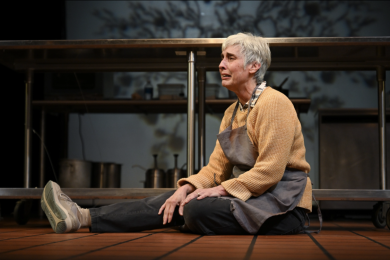REVIEW: Whose youth is it?
Review

I have been thinking a lot about white people problems over the last couple of weeks. The recent verdicts (or non-verdicts) in both Ferguson and Staten Island have made it painfully clear that white people in this country often do not suffer the same consequences as everyone else. Because these events feel so raw and so brutal, I find myself unable to think about Sidecar Theatre’s current production of Kenneth Lonergan’s This is Our Youth without dwelling on the politics of the play itself. Sidecar is a new company with some obvious talent — I will talk about their new production further on in this essay — and I hope they will forgive me for sidelining their work for a moment.
At no other point in my lifetime have I been so keenly aware that American racism is not shamefully hidden away, but overtly declared through law enforcement and judicial procedures. With the light that is now shining on our country’s deep currents of segregation, I can’t even look at the title of This is Our Youth without asking, whose youth are we talking about here?
The play, which takes place on the New York’s Upper West Side in 1982, tells the story of Warren, a 19-year-old who gets kicked out of his house and steals $15,000 on the way. He appears at his friend Dennis’s apartment – which is being paid for, incidentally, by Dennis’s parents. These are two kids with a major safety net (something that Warren acknowledges late in the play).
Their class privilege is important, but there are plenty of great plays about rich people that have a broad appeal. What is so problematic to me, given the current political climate, is that the play is also about Warren and Dennis trying to sell drugs in order to repay Warren’s dad. Considering the extreme racial disparities in drug sentencing, that means This is Our Youth is not just about class privilege, but racial privilege as well. What do you think a play about two black kids with daddy issues trying to sell cocaine would look like?
The play premiered off-Broadway in 1996, but there is a timeless quality to this play in the same way that you could call Catcher in the Rye “timeless”. Having attended a private high school in New York in the early 2000s, I can see echoes of some of my classmates in Holden Caulfield’s urban wanderings, just as I can see echoes in Dennis’s reaction to his absent artist father and Warren’s overestimation of his ability to deal with grown-up problems. But there is a risk in calling this play timeless, since “timeless” is so often equated to “universal”. This is hardly “our” youth, unless you belong to a pretty limited group of upper-class white men.
After such a long digression, let me get back to Sidecar’s production, starting with its location. The company has set the play in a house in North Minneapolis. I’m not sure how I feel about driving to North Minneapolis to watch a play about rich white kids and drugs, since it seems like there may be other stories in North Minneapolis that need to be told, but dramatically, the house itself is a brilliant choice.
The ground floor has the kind of open floor plan that allows for spectators to sit on either end of the room, with a kitchen and living area in the middle. It is clear that the actors have spent enough time rehearsing in this space that it feels like they really live there. At one point, Dennis actually cooks a frozen pizza in the oven. It feels like we are spying on these kids’ most critical coming-of-age moments. It’s intimate, and that’s what the script calls for.
The characterizations of all three roles – Warren, Dennis, and Warren’s love interest Jessica – are clearly drawn and unique, which is saying something given that this play has been serving as a star vehicle for actors like Mark Ruffalo, Jake Gyllenhaal, Anna Paquin, and Michael Cera ever since its premiere in 1996. But Paul LaNave, Richard Weber, and Molly Adams make the roles their own. LaNave paints a vivid portrait of Warren as physically awkward and emotionally unequipped for the real world. There are moments where he reminded me of Michael Cera, but if you’ve seen “Arrested Development,” you know that Cera has made his career playing awkward, emotionally unequipped people. LaNave’s performance does not come across as derivative, but rather as an effective portrayal of a character type that also happens to be in Cera’s wheelhouse.
Molly Adams does a very strong job as Jessica; I would have liked to see more of her. Jessica has a 19-year-old’s thirst for adventure and eagerness to please, but she is also smart – smart enough, ultimately, to get out of a bad situation. And Adams and LaNave have good chemistry during their scenes together, particularly during what might be the most awkward dance scene I have ever seen (sit on the kitchen side of the stage for the full effect).
Playing Dennis, who is constantly on his way up or down from a high, Richard Weber has his physicality down to a tee, flitting back and forth between arrogant swagger and frenetic nervousness. But his volume knob is turned up a few notches too high, so Dennis’s drug-fueled combination of testosterone and insecurity comes across like a clear-cut case of antisocial personality disorder. Although Warren calls Dennis a sociopath at one point, I’d like to assume that Lonergan meant that as hyperbole, because some more shading in Weber’s performance would make his character more interesting and, frankly, less exhausting to watch.
This is Our Youth was Kenneth Lonergan’s first hit play (some of his later film successes include Analyze This and You Can Count on Me), and its fast-paced, clever dialogue caught audiences’ interest. As the Sidecar Theatre’s debut production, this play also makes me want to see what else the company can do. The company made smart and interesting choices, and its actors are talented and energetic. At another time, maybe I wouldn’t have been distracted by what makes Warren and Dennis privileged enough to use drug dealing as a tool for figuring out the meaning of adulthood. Little did Sidecar know that their production would come at a time when, with all of the dramas being played out on the national stage, the problems of the white, privileged classes seem less relevant than ever.




